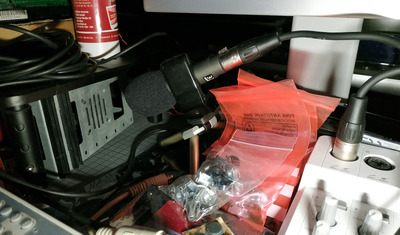Tiido wrote on 2022-03-30, 13:05:
Raw PC speaker signal is 5 or 3.3Vpp squarewave, depending on particular hardware. Most recording devices need much less than that, so something likely needs to be done to prevent possible damage. There are some circuits on this forum somewhere that turn the PC speaker output into something resembling line out that you can then record safely.
Hello, I am newbie on this forum, and my English is not good. I am russian medical devices engineer. I use decimal comma, not dot.
Generic unbalanced dynamic microphone input should be able to record 50 mV (0,050 V) sine wave undistorted. It also known as „magnetic head input” or „magnetic cartridge input” — it is all different, but on this abstraction level it is all a same.
Generic line input (and output vise versa) is operate with sine up to 500 mV (0,5 V) and impedance of load between 1000~100 Ohms. Usually this is an output of correction amplifier (in case of magnetic cartridge) or preamp (in case of microphone).
Generic headphone output operates with impedance 70~15 Ohms and voltage levels 500~2000 mV (0,5~2 V). At today technology level, line and headphone outputs are same, but in 1980's it was two different outputs — remember this!
Now we need to record signal from square low impedance output using sine middle impedance input. It is very easy — we need an attenuator. In case of big relational difference of impedances, we need to save original loudspeaker for impedance negotiation and connect an two resistors in series between loudspeaker terminals. The voltage on resistor, connected to Ground terminal (Rminus), is smaller, than overall voltage. And relation between voltages is a fraction:
Vminus = (Rminus) / (Rminus + Rplus)
Ok, this is very simplyfied theory, but what we shall to do in practice?
We need: Soldering Iron (15~50 W power), few wires (simular to loudspeaker's wires), connector for your soundcard (usually TRS jack), and an Trimming Resistor. I recoomend use any Bourns 3296 series in any style, but resistanse shold be 100 Ohm (Bourns resistanse code is 101). It is possiible to use 3296W-1-101, 3296P-1-101, 3296X-1-101 or equivalent from any another manufacturer.
First time you need to initialise your Trimmer. If you have no Ohmmeter at home or office, you may ask for help in shop (at least, in Russia this trick is useful). You need { (0,5 V /5 V) * 100 Ohm = 10 Ohm} between terminals 1 and 2 of Trimmer. If you have no meters, you may check the number of turns for full whiper travel in datasheet of your trimmer (25 turns for Bourns 3296), rotate some more CCW, and 10% of full to CW (2,5 turns for 3296). And 100 Ohm with 5 Volts provide 0,050 Ampers of current or 5 V * 0,050 A = 0,25 Watts of power — it is less than fire burning limit.
Now solder wires from pin 1 of trimmer to the Speaker ground (usually Black wire, connected to minus of the Loudspeaker) and to TRS Jack ground (usually S). Then solder an wire between pin 2 of Trimmer and Tip of the TRS Jack. And solder last wire between pin 3 and the plus of loudspeaker.
NOW CHECK ALL CONNECTIONS, DOUBLE CHECK POLARITY OF LOUDSPEAKER AND ITS CONNECTOR. And you should understand, what connecting two PC via wires is electricaly unsafe — TRIPLE CHECK YOU GROUNDING FOR YOUR (not PC) SAFETY!!!
You must control signal level on trimmer using small screwdriver. Sound should be undistorted. In any distortion you should slowly rotate wiper screw of Trimmer CCW.
I have no chanses to make pictures until tomorrow evening. But I will draw them if you requested.
Best regards,
Mikhail "SMA" Shpak
unemployed Service Engineer
(foremly work in Bakulev Science Center, DRG (Moscow represetative office), and few medical equipmet dealers and distributors in Russia).
